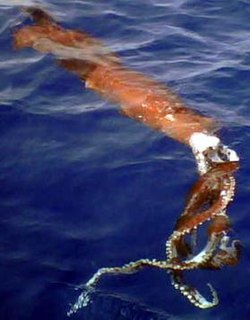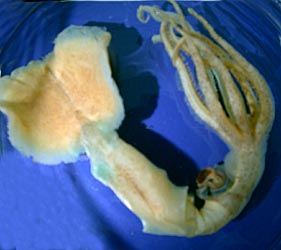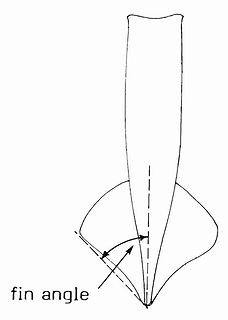
Loliginidae, commonly known as pencil squids, is an aquatic family of squid classified in the order Myopsida.

The Mastigoteuthidae, also known as whip-lash squid, are a family of small deep-sea squid. Approximately 20 known species in six genera are represented, with members found in both the mesopelagic and bathypelagic zone of most oceans. Originally described by Verill in 1881, it was later lowered by Chun (1920) to a subfamily (Mastigoteuthinae) of the Chiroteuthidae. However, Roper et al. (1969) raised it back to the family level, and this has not been changed since. The taxonomy of this family is extremely unstable, and there have been at times one genus, two genera and four subgenera(Salcedo-Vargas & Okutani, 1994), two genera and several 'groups', five genera and one species with an uncertain placement, or six genera.

Ommastrephidae is a family of squid containing three subfamilies, 11 genera, and over 20 species. They are widely distributed globally and are extensively fished for food. One species, Todarodes pacificus, comprises around half of the world's cephalopod catch annually.

The hooked squid, family Onychoteuthidae, currently comprise about 20–25 species, in six or seven genera. They range in mature mantle length from 7 cm to a suggested length of 2 m for the largest member, Onykia robusta. The family is characterised by the presence of hooks only on the tentacular clubs, a simple, straight, funnel–mantle locking apparatus, and a 'step' inside the jaw angle of the lower beak. With the exception of the Arctic Ocean, the family is found worldwide.

Cephalopods vary enormously in size. The smallest are only about 1 centimetre (0.39 in) long and weigh less than 1 gram (0.035 oz) at maturity, while the largest—the giant and colossal squids—can exceed 10 metres (33 ft) in length and weigh close to half a tonne (1,100 lb), making them the largest living invertebrates. Living species range in mass more than three-billion-fold, or across nine orders of magnitude, from the lightest hatchlings to the heaviest adults. Certain cephalopod species are also noted for having individual body parts of exceptional size. The giant and colossal squids, for example, have the largest known eyes among living animals.
Magnoteuthis is a genus of whip-lash squid containing at least three species. Some teuthologists consider Idioteuthis or Mastigoteuthis synonymous with this taxon, but it is genetically and morphologically distinct.

Asperoteuthis acanthoderma is a large species of squid belonging to the family Chiroteuthidae. It is characterised by the tiny, pointed tubercules present on its skin and a Y-shaped groove in the funnel locking apparatus.
Moroteuthopsis is a genus of squid in the family Onychoteuthidae. The type species is Moroteuthopsis longimana.

Amphorateuthis alveatus is a species of bobtail squid native to the Indian Ocean. It is characterised by unique modifications of the arms in males; mature males exhibit elongate suckers in numerous series on arm pairs II and IV.

Asperoteuthis mangoldae, previously known as Asperoteuthis sp. A, is a chiroteuthid squid known only from the waters off the Hawaiian Islands. It differs from the closely related Asperoteuthis acanthoderma in lacking integumental tubercles and elongate fins. This species also possesses a characteristic curved groove in its funnel locking apparatus.
Promachoteuthis sulcus is a species of promachoteuthid squid. It is distinguished from related taxa on the basis of several morphological features: nuchal fusion between the head and mantle, much larger size of arm suckers compared to club suckers, greater width of tentacle base than arm base, a recessed club base, and the presence of an aboral tentacle groove.
Alloteuthis africana, also known as the African squid, is a species of squid in the family Loliginidae. This species of squid is restricted to the Guinean province. To identify the Alloteuthis africana from other Alloteuthis congeners, it is highly recommended to measure the width of the squids head and the sucker size.
Asperoteuthis nesisi is a chiroteuthid squid of the genus Asperoteuthis. It is native to the waters off South Georgia and, more generally, the Southwest Atlantic. Asperoteuthis nesisi has a thin mantle and arms, and peculiar integumental tubercles on its head and mantle. The largest arm suckers possess twelve to fourteen sharp, triangular teeth.
Asperoteuthis lui is a chiroteuthid squid of the genus Asperoteuthis. This species was discovered from the stomach contents of a ling, a species of fish. The damaged specimen did not include a funnel or a mantle, but had multiple arms, one tentacle, and eyes. It was initially identified as a species of giant squid of the genus Architeuthis.

Illex coindetii, commonly known as the southern shortfin squid or broadtail shortfin squid, is a species of neritic squids in the family Ommastrephidae. They are found in the Mediterranean Sea and on both sides of the north Atlantic Ocean.

Illex oxygonius, commonly known as the sharptail shortfin squid, is a species of neritic squids in the family Ommastrephidae. Of the species of the genus Illex, they have the most restricted range, being found only in the western North Atlantic Ocean; from off New Jersey, south to the Straits of Florida and into the Gulf of Mexico. They are very difficult to distinguish from Illex coindetii and Illex illecebrosus, with which their geographic range overlaps. The most obvious difference of I. oxygnius is their sharper fin angles of 25° to 40°. There is also the possibility that they may be a hybrid of I. coindetii and I. illecebrosus.

Cephalopod fins, sometimes known as wings, are paired flap-like locomotory appendages. They are found in ten-limbed cephalopods as well as in the eight-limbed cirrate octopuses and vampire squid. Many extinct cephalopod groups also possessed fins. Nautiluses and the more familiar incirrate octopuses lack swimming fins. An extreme development of the cephalopod fin is seen in the bigfin squid of the family Magnapinnidae.

Cephalopods exhibit various dermal structures on their mantles and other parts. These may take the form of conspicuous warts, cushions, papillae or scales, though in many species they are microscopic tubercles. The most elaborate forms are found among the oceanic squid of the order Teuthida.

Uroteuthis is a genus of 14 species of common inshore squids of the Indo-West Pacific and is further subdivided into 3 subgenera. The members of the genus Uroteuthis are the only squids of the family Loliginidae that possess photophores and all species in the genus have a pair of photophore organs on the ventral surface of their ink sac either side of their intestine.
Richard E. Young is a teuthologist. He is an Emeritus Professor of Oceanography at the University of Hawaii's School of Ocean and Earth Science and Technology.













